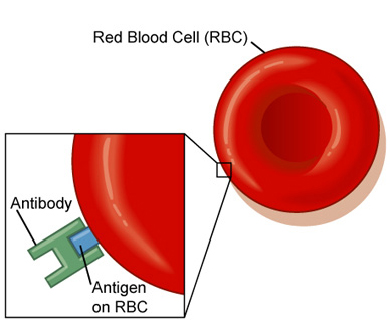Coombs' Test
What is a Coombs' test?
A Coombs' (or direct antiglobulin) test detects the presence of immunoglobulins (antibodies) on the surface of red blood cells. Immunoglobulins are proteins made by white blood cells (specifically plasma cells). The Coombs' test detects these immunoglobulins using specific antiserum that reacts against different types of immunoglobulins. If this antiserum detects immunoglobulins on the surface of the red blood cells, it will cause the red blood cells to agglutinate or clump in the test tube. For this test, a single blood sample is sent to a veterinary reference laboratory.
When is a Coombs' test indicated?
A Coombs' test is indicated if it is suspected that a pet has immune-mediated hemolytic anemia.
What is immune mediated hemolytic anemia (IMHA)?
"Immune mediated hemolytic anemia is one of the most prevalent immune mediated disorders in dogs and cats."
 Immune mediated hemolytic anemia is one of the most prevalent immune mediated disorders in dogs and cats. It is a condition whereby the red blood cells become coated with immunoglobulins (antibodies), leading to the premature destruction of these red blood cells by the animal's own body. Coated red blood cells will be destroyed (hemolysed) either within the blood stream or by specialized white blood cells (macrophages) within the spleen or liver.
Immune mediated hemolytic anemia is one of the most prevalent immune mediated disorders in dogs and cats. It is a condition whereby the red blood cells become coated with immunoglobulins (antibodies), leading to the premature destruction of these red blood cells by the animal's own body. Coated red blood cells will be destroyed (hemolysed) either within the blood stream or by specialized white blood cells (macrophages) within the spleen or liver.
The causes of immune mediated hemolysis can generally be divided into two categories, which are primary (also called idiopathic) and secondary.
With primary immune mediated hemolytic anemia the underlying reason that antibodies are being produced against an animal's red blood cells remains unclear or unknown. With secondary immune-mediated hemolytic anemia, the production of antibodies against red blood cells is secondary to another condition such as infection, allergy, inflammation or neoplasia (cancer). Certain drugs are known to trigger immune mediated hemolytic anemia in susceptible animals - however, the effects of these drugs on individual animals cannot be predicted or foretold.
Are there any other ways to diagnose immune mediated hemolytic anemia?
The condition will be suspected in any animal that has clinical symptoms such as pale gums or unexplained weakness, and characteristic laboratory evidence of immune mediated red blood cell destruction.
Laboratory evidence of immune mediated red blood cell destruction includes a mild to severe anemia accompanied by strong evidence of new red blood cell production. The presence and degree of anemia is determined by a complete blood count (CBC), and the accompanying blood smear will be used to identify the presence of increased new red blood cell production. The new red blood cells are called polychromatic erythrocytes (erythrocyte is Latin for red blood cells), or if a special stain is used, reticulocytes.
Another cell that may be present in higher numbers on the blood smear is the spherocyte. Spherocytes are red blood cells that are very dense and rounded in appearance (the normal red blood cell is flattened in shape), and are formed when a portion of the red blood cell membrane is removed in the spleen or liver because of the presence of immunoglobulins on the membrane surface. Occasionally there will be evidence of red blood cell clumping or agglutination on the slide. This clumping is caused by the presence of immunoglobulins attached to the surfaces of red blood cells.
A serum chemistry profile may indicate an increase in bilirubin. Bilirubin is a compound formed in the liver due to the breakdown of red blood cells. Normally bilirubin is found in small amounts in a serum sample, but with immune mediated destruction of red blood cells, the amount of bilirubin will increase.
"The Coombs' test may provide further confirmation of the presence of immunoglobulin on the red blood cell surface."
 Taken together, the physical findings and the laboratory data may suggest that immune-mediated destruction of red blood cells is the most likely cause of your pet's anemia. The Coombs' test may provide further confirmation of the presence of immunoglobulin on the red blood cell surface.
Taken together, the physical findings and the laboratory data may suggest that immune-mediated destruction of red blood cells is the most likely cause of your pet's anemia. The Coombs' test may provide further confirmation of the presence of immunoglobulin on the red blood cell surface.
What does a positive test result mean?
A positive Coombs' test means that the red blood cells are coated with hundreds of immunoglobulins. A positive result, taken along with other corroborative laboratory data and clinical signs, is supportive of immune mediated destruction of red blood cells. However, a positive Coombs' test does not allow us to determine if the red blood cell destruction is due to primary or secondary immune mediated hemolysis.
Because positive Coombs' test results can sometimes occur in animals without immune mediated hemolytic anemia, it is important to determine whether the CBC and serum biochemistry panels contain supportive evidence for immune mediated red blood cell destruction.
What does a negative test result mean?
A negative result can indicate that your pet does not have immune mediated hemolytic anemia. However, it is important to know that a false negative Coombs' test result is seen in approximately 10% to 30% of dogs with immune mediated hemolytic anemia. False negatives occur because red blood cell hemolysis can occur with as few as 20 to 30 molecules of antibody attached to the red blood cell, whereas the Coombs' test requires the presence of more than 200 to 300 molecules before a positive result is noted.
Recent treatment with steroids may cause a Coombs' test to be falsely negative.






